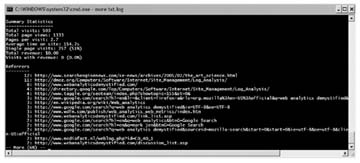Leverage Referring Domains and URLs
Knowing how visitors found you is as or more important than knowing what they do on your web site. Referring URLs are (usually) the source of this type of information.
A site or page’s referrer is usually the URL a visitor was browsing when he clicked a link to your web site. Captured via the web server logfile [Hack #22] or reported by a JavaScript page tag [Hack #28] , referring URLs are a powerful ally for the online marketer. Without referrers, you have no way to know who is talking about you, what they’re saying, or how well your marketing dollars are being spent. While in a perfect world every request would contain a referrer that would help you understand a visitor’s intent, the world is far from perfect.
How Referring URLs Are Typically Reported
Nearly all web measurement programs provide a basic top-level referring domains report as well as an option to drill down into the details of each referring URL. Data overload is a common problem when you’re thinking about your referrers, and often it’s best to simplify your referrers to show only the domain. However, in some cases you’ll be forced to analyze the entire referring URL (Figure 3-15).

Figure 3-15. Referring URLs report
Common Problems with Referrers
Since the referrer exists only when a link is constructed from another site to yours, the referrer is one of the most exciting things to a ...
Get Web Site Measurement Hacks now with the O’Reilly learning platform.
O’Reilly members experience books, live events, courses curated by job role, and more from O’Reilly and nearly 200 top publishers.

